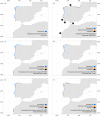Major shifts at the range edge of marine forests: the combined effects of climate changes and limited dispersal
- PMID: 28276501
- PMCID: PMC5343584
- DOI: 10.1038/srep44348
Major shifts at the range edge of marine forests: the combined effects of climate changes and limited dispersal
Abstract
Global climate change is likely to constrain low latitude range edges across many taxa and habitats. Such is the case for NE Atlantic marine macroalgal forests, important ecosystems whose main structuring species is the annual kelp Saccorhiza polyschides. We coupled ecological niche modelling with simulations of potential dispersal and delayed development stages to infer the major forces shaping range edges and to predict their dynamics. Models indicated that the southern limit is set by high winter temperatures above the physiological tolerance of overwintering microscopic stages and reduced upwelling during recruitment. The best range predictions were achieved assuming low spatial dispersal (5 km) and delayed stages up to two years (temporal dispersal). Reconstructing distributions through time indicated losses of ~30% from 1986 to 2014, restricting S. polyschides to upwelling regions at the southern edge. Future predictions further restrict populations to a unique refugium in northwestern Iberia. Losses were dependent on the emissions scenario, with the most drastic one shifting ~38% of the current distribution by 2100. Such distributional changes might not be rescued by dispersal in space or time (as shown for the recent past) and are expected to drive major biodiversity loss and changes in ecosystem functioning.
Conflict of interest statement
The authors declare no competing financial interests.
Figures





Similar articles
-
Future climate change is predicted to shift long-term persistence zones in the cold-temperate kelp Laminaria hyperborea.Mar Environ Res. 2016 Feb;113:174-82. doi: 10.1016/j.marenvres.2015.11.005. Epub 2015 Nov 11. Mar Environ Res. 2016. PMID: 26608411
-
Projected climate changes threaten ancient refugia of kelp forests in the North Atlantic.Glob Chang Biol. 2018 Jan;24(1):e55-e66. doi: 10.1111/gcb.13818. Epub 2017 Aug 17. Glob Chang Biol. 2018. PMID: 28710898
-
Spatiotemporal variability in population demography and morphology of the habitat-forming macroalga Saccorhiza polyschides in the Western English Channel.Ann Bot. 2024 Mar 8;133(1):117-130. doi: 10.1093/aob/mcad181. Ann Bot. 2024. PMID: 37962600 Free PMC article.
-
Threats and knowledge gaps for ecosystem services provided by kelp forests: a northeast Atlantic perspective.Ecol Evol. 2013 Oct;3(11):4016-38. doi: 10.1002/ece3.774. Epub 2013 Sep 15. Ecol Evol. 2013. PMID: 24198956 Free PMC article. Review.
-
Revisiting the 'bank of microscopic forms' in macroalgal-dominated ecosystems.J Phycol. 2021 Feb;57(1):14-29. doi: 10.1111/jpy.13092. Epub 2020 Dec 2. J Phycol. 2021. PMID: 33135166 Review.
Cited by
-
Carbon assimilation and transfer through kelp forests in the NE Atlantic is diminished under a warmer ocean climate.Glob Chang Biol. 2018 Sep;24(9):4386-4398. doi: 10.1111/gcb.14303. Epub 2018 Jun 3. Glob Chang Biol. 2018. PMID: 29862600 Free PMC article.
-
Predicting the comprehensive geospatial pattern of two ephedrine-type alkaloids for Ephedra sinica in Inner Mongolia.PLoS One. 2023 Apr 21;18(4):e0283967. doi: 10.1371/journal.pone.0283967. eCollection 2023. PLoS One. 2023. PMID: 37083689 Free PMC article.
-
Global floating kelp forests have limited protection despite intensifying marine heatwave threats.Nat Commun. 2025 Apr 3;16(1):3173. doi: 10.1038/s41467-025-58054-4. Nat Commun. 2025. PMID: 40180911 Free PMC article.
-
Fine-scale abundance of rocky shore macroalgae species with distribution limits in NW Iberia in 2020/2021.Biodivers Data J. 2022 Apr 4;10:e80798. doi: 10.3897/BDJ.10.e80798. eCollection 2022. Biodivers Data J. 2022. PMID: 35437402 Free PMC article.
-
Phylogeographic diversification and postglacial range dynamics shed light on the conservation of the kelp Saccharina japonica.Evol Appl. 2019 Jan 12;12(4):791-803. doi: 10.1111/eva.12756. eCollection 2019 Apr. Evol Appl. 2019. PMID: 30976310 Free PMC article.
References
-
- Chen I. C., Hill J. K., Ohlemüller R., Roy D. B. & Thomas C. D. Rapid range shifts of species associated with high levels of climate warming. Science 333, 1024–1026 (2011). - PubMed
-
- Hampe A. & Petit R. J. Conserving biodiversity under climate change: The rear edge matters. Ecol. Lett. 8, 461–467 (2005). - PubMed
-
- Hoegh-Guldberg O. & Bruno J. F. The impact of climate change on the world’s marine ecosystems. Science 328, 1523–1528 (2010). - PubMed
-
- Steneck R. S. et al.. Kelp forest ecosystems: biodiversity, stability, resilience and future. Environ. Conserv. 29, 436–459 (2002).
Publication types
MeSH terms
LinkOut - more resources
Full Text Sources
Other Literature Sources
Miscellaneous

